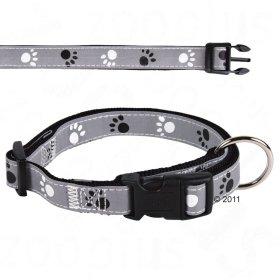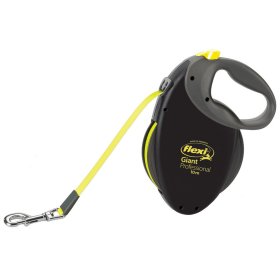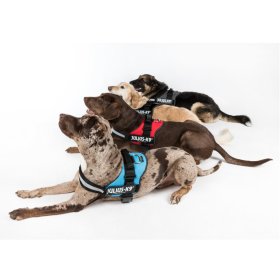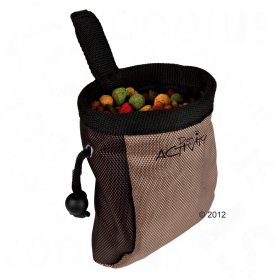Dog Collars, Leads & Harnesses

Biodegradable Dog Poop Bags with Handles
100 Bags
Delivery in 1-3 working days
Dog Poop Bags - Black
20 Rolls (20 bags per roll)
Delivery in 1-3 working days
Beco Unscented Dog Poop Bags
120 Bags (8 Rolls)
Delivery in 1-3 working days
Biodegradable Dog Poop Bags with Handles
50 Bags
Delivery in 1-3 working days
Fun & Sport Dog Agility Hurdle
1 x Hurdle
Delivery in 1-3 working days
Biodegradable Dog Poop Bags
4 rolls (15 bags per roll)
Delivery in 1-3 working days
Trixie Garden Dog Lead
5m
Delivery in 1-3 working days
Trixie Extra Light Tracking Lead - Graphite
15m x 10mm (L x W)
Delivery in 1-3 working days
Fun & Sport Dog Agility Jumping Hoop
Diameter 55cm
Delivery in 1-3 working days
Trixie Dog Lead Anchor
Ground Spike
Delivery in 1-3 working days
Trixie Reflective Paws Dog Collar - Silver
Size S-M
Delivery in 1-3 working days
ADAPTIL® Calm Collar for Dogs
Large
Delivery in 1-3 working days
flexi New Classic harness lead red, 5 m
M: up to 25 kg
Delivery in 1-3 working days
Nomad Tales Blush Harness - Emerald
Size M: 53 - 71 cm Chest Circumference, 20mm Width
Delivery in 1-3 working days
Fun & Sport Dog Agility Tunnel - Chute
500 x 60 x 60 cm (L x W x H)
Delivery in 1-3 working days
Hand-held Poop Scooper
60 x 13 cm (L x W)
Delivery in 1-3 working days
HUNTER Neoprene Lead – Black/ Grey 200cm
200cm & adjustable
Delivery in 1-3 working days
Trixie Garden Dog Lead - 8m
8m
Delivery in 1-3 working days
Nomad Tales Blush Collar - Taupe
Size L: 39 - 64 cm Neck Circumference, 25mm Width
Delivery in 1-3 working days
Trixie Reflective Paws Dog Collar - Silver
Size M-L
Delivery in 1-3 working days
Trixie High Frequency Dog Whistle - With Frequency Protection
8cm
Delivery in 1-3 working days
Trixie USB Flash Light Collar - Green
Neck size: up to 50cm
Delivery in 1-3 working days
ADAPTIL® Calm Collar for Dogs
Small/Medium
Delivery in 1-3 working days
Nomad Tales Spirit Collar - Tangerine
Size S: 36 - 40 cm Neck Circumference, 30mm Width
Delivery in 1-3 working days
Dog collars – The right collar for every dog
Dog walking accessories come in all kinds of shapes and designs – be they power harnesses, simple collars or even muzzles. You can find a huge range of walking accessories in our bitiba dog shop – and find out more about the different types and materials for dog collars. As well, we inform you about familiarisation and the right age for dog collars.
Dog collars – The right collar for every dog
Dog walking accessories come in all kinds of shapes and designs – be they power harnesses, simple collars or even muzzles. You can find a huge range of walking accessories in our bitiba dog shop – and find out more about the different types and materials for dog collars. As well, we inform you about familiarisation and the right age for dog collars.
What dog collars are there?
Common dog collars are used in conjunction with a lead for safety and to prevent dogs from running away. In addition, there are special collars with several special functions, including reflective collars and flashlight collars with LEDs for improved visibility in the dark. Flea collars are a preventive health measure and protect dogs from infestation by fleas or other parasites like lice and ticks.
What dog collars are there?
Common dog collars are used in conjunction with a lead for safety and to prevent dogs from running away. In addition, there are special collars with several special functions, including reflective collars and flashlight collars with LEDs for improved visibility in the dark. Flea collars are a preventive health measure and protect dogs from infestation by fleas or other parasites like lice and ticks.
What material is good for dog collars?
Leather is a popular material for high-quality dog collars. As a natural material, it is attractive in appearance and feel with a pleasant smell. As well, leather is robust and durable if you regularly grease the collar. You should thoroughly dry leather collars that get wet. Affordable, robust alternatives to leather collars can be made from synthetic fibres. These include, for instance, nylon or polyester, which are renowned for being easy to clean. Collars with a broad support area, soft padding and no metal parts offer additional advantages in terms of comfort.
What material is good for dog collars?
Leather is a popular material for high-quality dog collars. As a natural material, it is attractive in appearance and feel with a pleasant smell. As well, leather is robust and durable if you regularly grease the collar. You should thoroughly dry leather collars that get wet. Affordable, robust alternatives to leather collars can be made from synthetic fibres. These include, for instance, nylon or polyester, which are renowned for being easy to clean. Collars with a broad support area, soft padding and no metal parts offer additional advantages in terms of comfort.
From what point is a collar useful for dogs?
There is no minimum age for using dog collars. Using them early on has the advantage of them being less likely to encounter resistance. Some breeders already use collars with their puppies, so the matter of the appropriate time for you to start doing as the buyer of the dog becomes irrelevant. If this isn't the case, you should keep an eye on your dog's skin in the throat area to recognise potential allergic reactions early on. This primarily concerns collars with nickel. As with humans, this metal can trigger a contact allergy, although this is rare.
From what point is a collar useful for dogs?
There is no minimum age for using dog collars. Using them early on has the advantage of them being less likely to encounter resistance. Some breeders already use collars with their puppies, so the matter of the appropriate time for you to start doing as the buyer of the dog becomes irrelevant. If this isn't the case, you should keep an eye on your dog's skin in the throat area to recognise potential allergic reactions early on. This primarily concerns collars with nickel. As with humans, this metal can trigger a contact allergy, although this is rare.
What size should a dog collar be?
Dog collars shouldn't be fixed too loose or too tight. The maximum width is determined by the circumference of the head at its widest point. It should always be well below this. The lower limit is always more than the natural width of the throat. You can do the finger test to check that the collar fits well. Place two fingers beneath the collar. If it can still move easily, the tightness is acceptable to ensure your dog's wellbeing. Make sure too that there are no clasps or other metal parts on the underside of the collar.
What size should a dog collar be?
Dog collars shouldn't be fixed too loose or too tight. The maximum width is determined by the circumference of the head at its widest point. It should always be well below this. The lower limit is always more than the natural width of the throat. You can do the finger test to check that the collar fits well. Place two fingers beneath the collar. If it can still move easily, the tightness is acceptable to ensure your dog's wellbeing. Make sure too that there are no clasps or other metal parts on the underside of the collar.
How can you get a dog used to a collar?
Wearing a collar is new and unusual for dogs, so choose a familiar situation and surroundings. If you buy or adapt a dog that still hasn't worn a collar, first give it time to settle in with you. Besides, it's useful for the dog to already be familiar with the collar, so let your four-legged friend sniff away at it to its heart's content. You can also create positive associations with the dog collar by rewarding voluntary contact with a treat. If your dog shows any resistance the first time you put it on, abort the attempt and prolong the familiarisation phase.
How can you get a dog used to a collar?
Wearing a collar is new and unusual for dogs, so choose a familiar situation and surroundings. If you buy or adapt a dog that still hasn't worn a collar, first give it time to settle in with you. Besides, it's useful for the dog to already be familiar with the collar, so let your four-legged friend sniff away at it to its heart's content. You can also create positive associations with the dog collar by rewarding voluntary contact with a treat. If your dog shows any resistance the first time you put it on, abort the attempt and prolong the familiarisation phase.







































